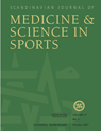Biomechanical analysis of anterior cruciate ligament injury mechanisms: three-dimensional motion reconstruction from video sequences
Abstract
Background: Methods for analyzing the mechanisms of injuries in sports from video sequences of injury situations are so far limited to a simple visual inspection, which has shown poor accuracy.
Purpose: To investigate whether a new model-based image-matching technique could successfully be applied to estimate kinematic characteristics of three typical anterior cruciate ligament (ACL) injury situations.
Methods: A four-camera basketballvideo, a three-camera European team handball video and a single-camera downhill skiing video were imported into the program Poser® 4, where a skeleton model and a model of the surroundings were matched to the background image frame by frame. When the match was considered satisfactory, joint angles as well as velocity and acceleration of the center of mass were calculated using Matlab®.
Results: In the basketball and handball matchings, the skeleton and surrounding models were successfully matched to the background through all frames in all camera angles. Detailed time courses for joint kinematics and ground reaction force were obtained, while less information could be acquired from the single-view skiing accident.
Conclusion: The model-based image matching technique can be used to extract kinematic characteristics from videotapes of actual ACL injuries, and may provide valuable information on the mechanisms for ACL injuries in sports.




